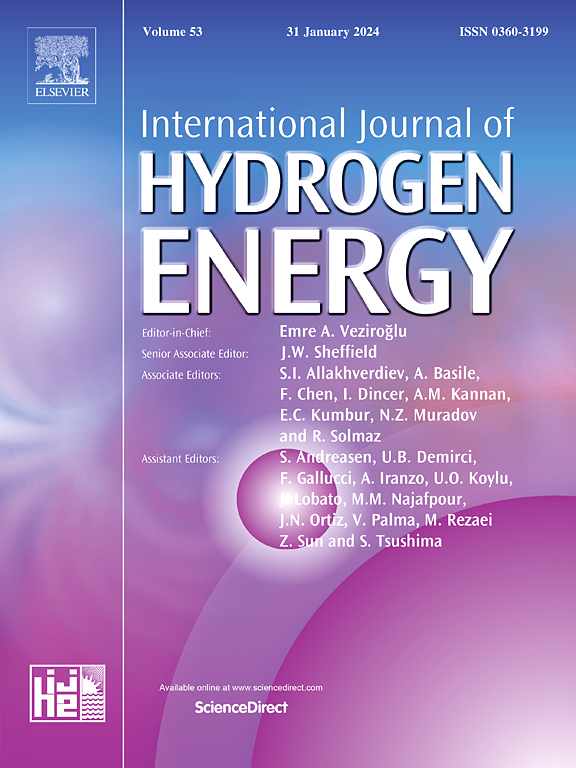Techno-economic analysis of green hydrogen production from wind and solar along CPEC special economic zones in Pakistan
IF 8.1
2区 工程技术
Q1 CHEMISTRY, PHYSICAL
引用次数: 0
Abstract
Hydrogen-based systems are garnering attention as part of efforts to achieve low-carbon emissions and net-zero targets. In developing countries, natural gas and coal serve as a primary source for hydrogen production, given their accessibility and cost-effectiveness. Green hydrogen presents a promising clean energy solution with significant potential to decarbonize the industrial sector. In this article, a techno-economic analysis has been performed for green hydrogen production using wind and solar as primary energy sources. The analysis is conducted at nine special economic zones (SEZs) and a free zone at Gwadar Sea Port using the Hybrid Optimization of Multiple Energy Resources (HOMER) Pro software. A hybrid energy system has been designed to meet the industrial electrical and hydrogen demand of 600 MWh/day and 60 tonnes H2 per day, respectively. A comparative analysis of on-grid and off-grid systems across all SEZs is performed for the optimal system. A sensitivity analysis is conducted on different parameters that could impact the levelized cost of hydrogen (LCOH). The results indicate that LCOH varies from 4.19 $/kg to 8.66 $/kg for off-grid and 2.12 $/kg to 4.65 $/kg for on-grid systems which is a competitive cost to other countries. The most feasible economic zones for green hydrogen production are found to be Dhabeji and Port Qasim with the lowest LCOH of 4.19 $/kg and 4.22 $/kg for off-grid, 2.12 $/kg and 2.36 $/kg for the grid-connected system, respectively. Dhabeji also exhibits the lowest CO2 emissions per year making itself the most feasible location for green hydrogen production. Grid-connected systems are a great opportunity for Pakistan to produce low-cost green hydrogen for industrial decarbonization and the country’s economic growth.
巴基斯坦中巴经济走廊经济特区风能和太阳能绿色制氢的技术经济分析
作为实现低碳排放和净零排放目标的一部分,氢基系统正受到关注。在发展中国家,由于天然气和煤炭的可获得性和成本效益,它们是生产氢气的主要来源。绿色氢是一种有前途的清洁能源解决方案,具有使工业部门脱碳的巨大潜力。本文对以风能和太阳能为主要能源的绿色制氢进行了技术经济分析。该分析是在九个经济特区(SEZs)和瓜达尔港的一个自由区使用多种能源混合优化(HOMER) Pro软件进行的。设计了一个混合能源系统,分别满足600兆瓦时/天和60吨H2 /天的工业电力和氢气需求。对所有经济特区的并网和离网系统进行了比较分析,以确定最优系统。对影响氢气平准化成本的不同参数进行了敏感性分析。结果表明,离网系统的LCOH从4.19美元/公斤到8.66美元/公斤不等,并网系统的LCOH从2.12美元/公斤到4.65美元/公斤不等,这对其他国家来说是具有竞争力的成本。最可行的绿色制氢经济区是Dhabeji和Port Qasim,离网系统的LCOH最低,分别为4.19美元/kg和4.22美元/kg,并网系统的LCOH最低,分别为2.12美元/kg和2.36美元/kg。达贝吉每年的二氧化碳排放量也最低,这使它成为绿色氢气生产最可行的地点。并网系统是巴基斯坦为工业脱碳和国家经济增长生产低成本绿色氢的绝佳机会。
本文章由计算机程序翻译,如有差异,请以英文原文为准。
求助全文
约1分钟内获得全文
求助全文
来源期刊

International Journal of Hydrogen Energy
工程技术-环境科学
CiteScore
13.50
自引率
25.00%
发文量
3502
审稿时长
60 days
期刊介绍:
The objective of the International Journal of Hydrogen Energy is to facilitate the exchange of new ideas, technological advancements, and research findings in the field of Hydrogen Energy among scientists and engineers worldwide. This journal showcases original research, both analytical and experimental, covering various aspects of Hydrogen Energy. These include production, storage, transmission, utilization, enabling technologies, environmental impact, economic considerations, and global perspectives on hydrogen and its carriers such as NH3, CH4, alcohols, etc.
The utilization aspect encompasses various methods such as thermochemical (combustion), photochemical, electrochemical (fuel cells), and nuclear conversion of hydrogen, hydrogen isotopes, and hydrogen carriers into thermal, mechanical, and electrical energies. The applications of these energies can be found in transportation (including aerospace), industrial, commercial, and residential sectors.
 求助内容:
求助内容: 应助结果提醒方式:
应助结果提醒方式:


